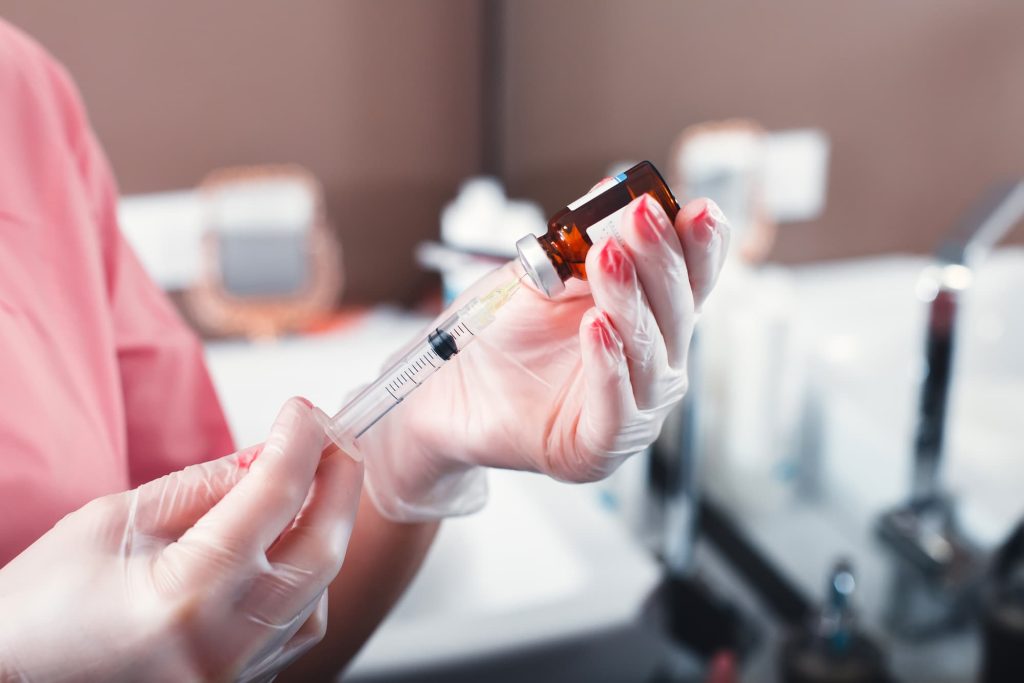Juvederm and Botox are popular aesthetic treatments that address various cosmetic concerns. Juvederm is a line of contouring and biorevitalization products based on stabilized hyaluronic acid, while Botox refers to botulinum toxin type A. Both treatments offer unique advantages and have distinct mechanisms of action, and in this article, we will dig into the differences between Botox and Juvederm, their benefits, side effects, and considerations for patient selection.
What Is Juvederm?
Juviderm is a brand of contouring and biorevitalization products based on stabilized hyaluronic acid.
The distinctive feature of Juvederm fillers is their high concentration of hyaluronic acid. Therefore, these products are used in cases where a powerful and highly pronounced effect is required. The fillers are transparent gels of varying densities packaged in disposable syringes for intradermal injections. Along with purified hyaluronic acid, they contain lidocaine, a local anesthetic.
The manufacturer of Juvederm products, Allergan, USA, holds a leading position in the field of aesthetic medicine (the creator of Botox and other products). It guarantees exceptional quality and product safety. Hyaluronic acid is ideal for correcting aesthetic defects, age-related changes, and signs of skin aging. It is fully biocompatible and does not cause allergic reactions. In addition, it completely dissolves in the skin over several months.
Juvederm fillers are used to replenish the age-related deficit of hyaluronic acid in the skin, fill in wrinkles, and correct facial tissue volume.
Hyaluronic acid primarily serves to preserve moisture in the skin, with a single molecule capable of retaining up to a thousand water molecules. As we age, the production and content of hyaluronic acid decrease, resulting in sagging, dullness, dryness, and skin thinning. Additionally, the activity of fibroblasts and collagen synthesis depends on the level of hyaluronic acid. A deficiency of collagen leads to sagging, decreased elasticity, loss of turgor, and the formation of wrinkles and folds.
Juvederm filler injections restore the content of hyaluronic acid and stimulate collagen synthesis. This achieves quick rejuvenating and corrective results:
- The skin is well-hydrated;
- Fine, medium, and deep wrinkles are smoothed out;
- Nasolabial and other folds are reduced;
- The contours of the cheeks, cheekbones, and chin are improved;
- The skin becomes tighter, more elastic, and firmer;
- Sagging at the corners of the mouth and eyelids is eliminated.
What Is Botox?
Botox is the name of a botulinum toxin type A brand that is used for the prevention of facial wrinkles in many countries around the world. However, colloquially, people often refer to all botulinum toxin products as Botox, regardless of whether the specific product administered has a different name or is manufactured by another company.
Botulinum toxin, also known as botulism toxin, is a protein neurotoxin produced by bacteria of the Clostridium botulinum type. Although botulinum toxin is indeed classified as an organic poison, numerous (including independent) studies have shown its safety when used in the doses employed in aesthetic medicine and administered by professionals. At least as long as the needle is in the hands of a professional physician. Furthermore, this is the most common aesthetic procedure worldwide.
Botox has various uses in medicine and cosmetics, including:
- Wrinkle reduction
Temporarily paralyzes facial muscles to minimize facial wrinkles.
- Migraine treatment
Helps prevent and lessen the severity of migraine attacks.
- Hyperhidrosis treatment
Reduces excessive sweating when injected into armpits, palms, or soles of the feet.
- Facial contouring
Reshapes and lifts specific facial areas like the chin or corners of the mouth.
- Muscle spasm and dysfunction treatment
Alleviates spasms and improves muscle function in conditions like spastic paralysis or pain syndrome.
- Correction of unwanted facial expressions
Reduces muscle activity, causing undesirable expressions like lip puckering or nose scrunching.
Advantages of Juvederm
- A wide range of products to solve different cosmetic concerns.
- Long-lasting effect. On average, the results of Juvederm injections can last up to a year.
- Low risk of developing allergies.
- Uniformity and even distribution of the gels in the skin tissues.
- Juvederm dermal fillers have been successfully used for many years, gaining a reputation and certification in numerous countries worldwide.
Side Effects of Juvederm
Injections of Juvederm dermal fillers are contraindicated in the following cases:
- Age under 18 without parental consent;
- Pregnancy and lactation period;
- Autoimmune diseases – the treating physician makes the final decision individually, depending on the nature of the illness and ongoing treatment;
- Allergy to the components;
- Predisposition to developing hypertrophic scars;
- Acute stage of any infections;
- Inflammatory processes at the injection sites, including herpes;
- High body temperature.
Possible Side Effects:
- Redness and bruising at the injection sites;
- Peeling;
- Swelling;
- Minor swelling;
- Decreased skin sensitivity;
- Formation of nodules and hardening.
The recovery period in case of side effects lasts no more than 3-5 days. Complications resolve spontaneously and do not require additional medical intervention.
Advantages of Botox
- Non-surgical rejuvenation. Most plastic surgeries that yield significant results (such as facelifts, blepharoplasty, lipofilling, otoplasty, etc.) require rehabilitation.
- Preservation of natural facial expressions. Transforming the face into a mask is a common myth. With proper botulinum therapy, the absence of negative consequences is guaranteed.
- Fast results. Within a few days, patients experience visible results from Botox injections. The cumulative properties of the product come into play here, and with regular maintenance injections, the effect can be prolonged.
- Minimal pain sensation. For most patients, the procedure is painless as ultra-thin needles are used.
Botox can be used in conjunction with plastic surgery and other rejuvenation procedures.
Additional advantages include affordability and speed of the procedures. For example, even when treating multiple problem areas, the overall duration of the manipulations is at most 10-15 minutes.
Side Effects of Botox
Despite its proven safety at low doses, botulinum toxin is an organic poison. Therefore, there are several reasonable contraindications to its use, which include:
- Individual intolerance, allergies;
- Cancer, immune diseases;
- Myasthenic syndrome (LEMS);
- Acute infections, acute respiratory infections.
Botulinum toxin injection is not recommended during pregnancy and breastfeeding.
As for Botox side effects, they include:
- Temporary muscle weakness;
- Headache.
In rare cases, Botox injections can lead to more severe complications, such as difficulty swallowing or breathing. However, these instances are scarce when administered by a qualified professional.
Patient Selection
The difference between Botox and Juvederm is as follows:
- Botox: freezes the muscles, preventing wrinkles and folds caused by facial expressions. These are usually in the upper part of the face, such as the forehead wrinkles, and wrinkles around the eyes. Botox results last 3 to 4 months.
- Juvederm: includes hyaluronic acid to “fill in” or increase volume in areas that have lost volume and smoothness. These include wrinkles around the mouth, thin lips, and cheeks. It can also be applied to remove wrinkles on the forehead, scars, and other areas that need extra volume for a smoother appearance. Juvederm results vary depending on which product is used.
The choice between Juvederm versus Botox depends on different factors, including the desired outcome, the area being treated, and individual preferences. Moreover, sometimes patients should not decide which is better, Botox or Juvederm, since they can be combined in the same treatment.
Conclusion
When considering Botox and Juvederm for aesthetic treatments, it’s essential to understand their differences and choose the option that best suits individual needs and goals. Juvederm, with its high hyaluronic acid concentration, is particularly effective for replenishing volume, filling in wrinkles, and enhancing facial contours.
On the other hand, Botox creates visible results by temporarily paralyzing facial muscles that otherwise would cause the appearance of wrinkles from repeated facial expressions. While the longevity of the treatments have a set range for either product, Juvederm typically lasts longer than Botox. Ultimately, consultation with a qualified medical professional is a crucial step to determine the most suitable treatment to achieve the desired results.
FAQ
What are the Differences between Juvederm and Botox?
Juvederm is a dermal filler that works by enhancing volume, while Botox is a neurotoxin that relaxes facial muscles. They target different concerns: Juvederm fills wrinkles and adds volume, while Botox reduces the appearance of wrinkles caused by muscle movement.
Is Juvederm better than Botox?
The choice between Juvederm and Botox depends on individual preferences and specific treatment goals. For example, Juvederm is effective for adding volume and filling wrinkles, while Botox is more suitable for reducing wrinkles caused by muscle movement.
What lasts longer, Juvederm or Botox?
Generally, Juvederm fillers tend to last longer than Botox. The effects of Botox injections typically last around 3-4 months, while the Juvederm fillers effect lasts for 5 to 24 months, depending on the specific product used.





















